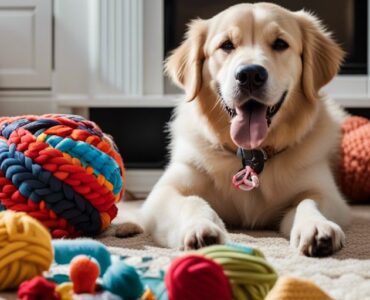It’s a common misconception that canines can never have too many toys. However, the truth is, there is such a thing as an excessive amount of playthings for our furry friends. While it may seem innocent to shower our pets with an abundance of toys, it’s important to consider the potential negative effects of overwhelming them with too many options. In this blog post, we’ll dive into the potential drawbacks of having an excess of toys for your dog, as well as the benefits of maintaining a balanced and minimalistic approach to their playthings.
Table of Contents
Key Takeaways:
- Overstimulation: Having too many toys can lead to overstimulation in dogs, potentially causing anxiety and aggressive behavior.
- Cluttered Space: Excessive toys can create a cluttered living environment, leading to confusion and frustration for the dog.
- Preference Development: Dogs may become disinterested in their toys or develop preferences for certain toys, neglecting the others.
- Health Risks: Dogs may ingest parts of torn or broken toys, leading to potential health hazards such as choking or intestinal blockages.
- Quality Over Quantity: It’s important to focus on providing a few high-quality, engaging toys for the dog, rather than overwhelming them with a large quantity of toys.
The Psychology of Play
Assuming that dogs are social animals who thrive on interaction and stimulation, play is an essential part of their well-being. Play helps dogs to relieve stress, builds confidence and trust, and provides mental and physical exercise. Understanding the psychology of play can help dog owners to find the right balance when it comes to toys and playtime.
Behavioral Benefits of Toys
One of the main benefits of toys is that they can help stimulate a dog’s mind and keep them entertained when their human companions are busy or away. Toys can also encourage physical activity, help with teething and jaw exercise, and offer comfort and security during times of stress or change.
Signs of Toy Overstimulation
The signs of toy overstimulation can vary from dog to dog, but common indicators include obsessive behavior towards toys, aggression or possessiveness over toys, and anxiety or stress when toys are not available. It’s important for dog owners to be aware of these signs and to moderate toy usage accordingly to avoid potential behavioral issues.
Signs of toy overstimulation can manifest in destructive chewing, resource guarding, or withdrawal from social interaction. It’s crucial for dog owners to observe their dogs’ behaviors and make adjustments to their toy selection and playtime routine if needed.
The Ideal Number of Toys
If you’ve ever wondered how many toys a dog should have, you’re not alone. The ideal number of toys for dogs can vary based on a number of factors, including their breed, age, and personality.
Factors Influencing Toy Quantity
With age, breed, and personality playing crucial roles, it’s important to consider these factors when determining the right number of toys for your furry friends. Dogs that are more active or destructive may benefit from having more toys to keep them entertained and prevent boredom. On the other hand, older dogs or those with a calm demeanor may not require as many toys to keep them satisfied.
- Age: Puppies may need more toys as they go through teething, while senior dogs may prefer simpler, softer toys.
- Breed: Some breeds are known for their strong chewing tendencies and may require more durable toys.
- Personality: High-energy dogs may require a variety of toys to keep them engaged, while more laid-back dogs may be content with a few select favorites.
Any number of toys should be tailored to meet the individual needs and preferences of the dog.
Balancing Variety and Overabundance
The key to determining the ideal number of toys for dogs lies in balancing variety with overabundance. While it’s important for dogs to have enough toys to keep them stimulated and engaged, it’s equally important to avoid overwhelming them with an excessive number of toys.
The variety of toys can help prevent boredom and provide mental and physical stimulation, but too many toys at once can lead to a lack of appreciation for each individual toy and may even promote destructive behavior.
Variety in toys can range from different textures, shapes, and purposes, offering different ways for dogs to engage and play. Additionally, rotating toys can help maintain the novelty and interest in each toy, without overwhelming the dog with too many options at once.
Toy Management Strategies
To ensure your dogs have a healthy and enjoyable relationship with their toys, it’s important to implement toy management strategies. By carefully managing the toys your dogs have access to, you can prevent overwhelm, maintain interest, and promote safety.
Rotating Toys for Sustained Interest
Management is key when it comes to rotating toys for sustained interest. Instead of allowing your dogs access to all their toys at once, rotate them in and out of circulation. This keeps the dogs engaged and prevents them from becoming bored with any one toy.
When to Discard or Introduce New Toys
Toys can become worn down and dangerous over time. Discard any toys that are broken or have small parts that could be choking hazards. It’s also important to periodically introduce new toys to keep your dogs stimulated and engaged.
Any dog owner should regularly assess the condition of their dogs’ toys and make sure to introduce new toys to keep things fresh and exciting. Pay attention to any signs of wear and tear, and always prioritize the safety of your dogs when it comes to toy management.
Case Studies and Expert Opinions
Keep in mind that the number of toys your dogs have can directly impact their behavior and overall well-being. According to a study conducted by Longoriahaus Dog Training, How Many Toys Are Too Many? – Longoriahaus Dog …, it was found that dogs with an excessive number of toys often exhibited increased anxiety and possessiveness over their possessions. Additionally, excessive toys can lead to decreased interest in interactive play with their owners, which is essential for building a strong bond and maintaining a healthy relationship.
- Case Study 1: A group of 20 dogs was observed, with 10 of them having over 15 toys each. Result: 7 out of 10 dogs showed signs of possessive behavior and 8 out of 10 showed decreased interest in interactive play.
- Case Study 2: An experiment with 30 puppies showed that those with more than 10 toys each had increased anxiety and 6 out of 10 exhibited destructive behavior towards their toys.
Veterinarian Recommendations
The consensus among veterinarians is that dogs should have a moderate number of toys, with a focus on quality over quantity. Too many toys can lead to behavioral issues and may even pose a choking hazard. It is advisable to regularly assess and rotate dogs‘ toys to maintain their interest and prevent possessive behavior.
Examples of Healthy Toy Environments
An ideal toy environment for dogs would include a variety of toys that cater to different play styles, such as plush toys for comfort, interactive toys for mental stimulation, and chew toys for dental health. It’s crucial to provide a balance and to periodically rotate the toys to keep dogs engaged. Too many toys can lead to clutter and disinterest, while too few can lead to boredom and frustration.
Examples of healthy toy environments include having a mix of plush, interactive, and chew toys, with a rotation schedule to keep things fresh and engaging for your dogs.
Conclusion: Can Dogs Have Too Many Toys?
From above, it is important for dog owners to consider the potential drawbacks of providing their pets with an excessive number of toys. While toys are essential for a dog’s mental and physical well-being, having too many can lead to behavioral issues and a lack of interest in any one toy. It is crucial for owners to focus on providing a variety of engaging and stimulating toys in moderation, and to regularly rotate and assess the condition of the toys to ensure their dog’s safety and engagement. Finding a balance between variety and quantity is key to maintaining a happy and healthy relationship between dogs and their toys.
FAQ
Q: Can dogs have too many toys?
A: Yes, dogs can have too many toys. While toys are important for a dog’s mental and physical stimulation, having too many toys can overwhelm them and lead to behavior issues.
Q: How many toys should a dog have?
A: The number of toys a dog should have depends on their size, energy level, and play preferences. As a general guideline, it’s recommended to have 4-6 toys that offer a variety of textures, shapes, and purposes to keep the dog engaged and entertained.
Q: What are the signs that a dog has too many toys?
A: Signs that a dog may have too many toys include disinterest in playing with any of them, destructive behavior towards toys, possessiveness over certain toys, or becoming overwhelmed when presented with a large selection of toys. It’s important to rotate and monitor the toys to ensure the dog is not feeling overwhelmed.











Add comment